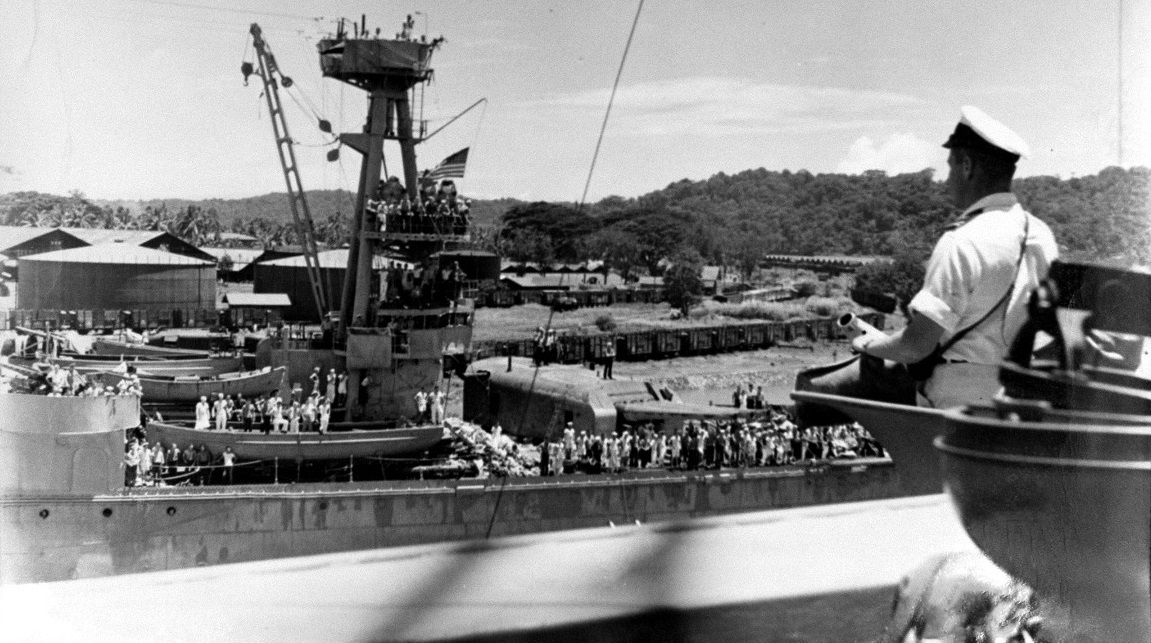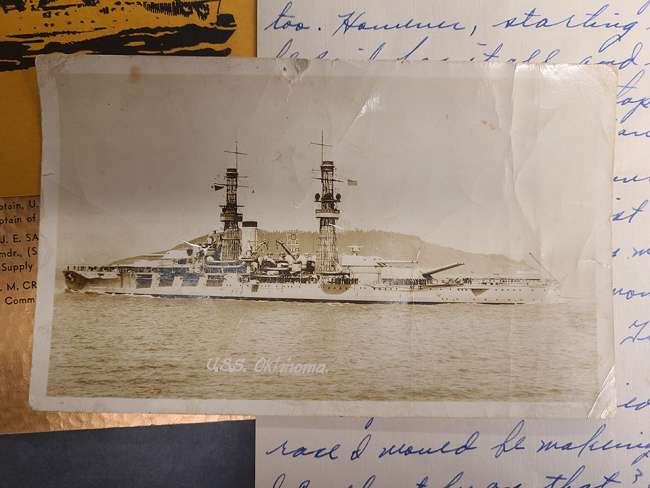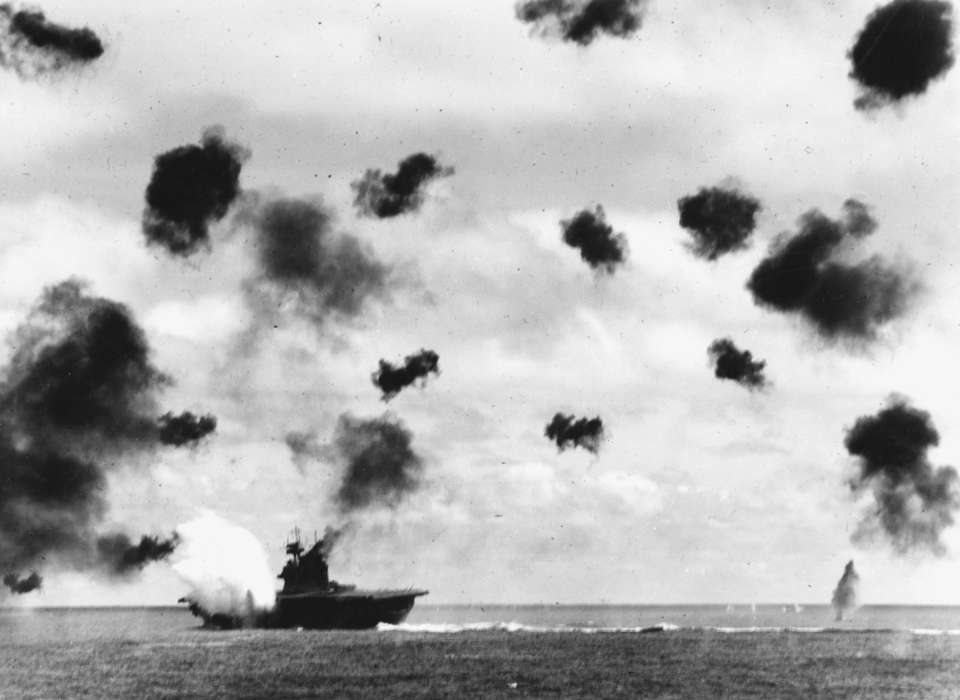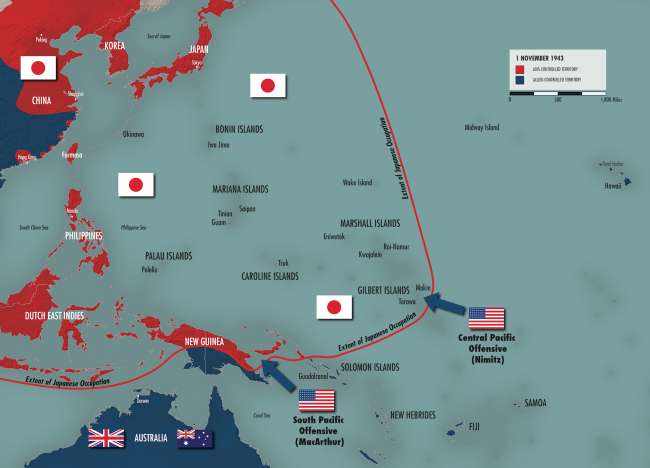Listen: Apple Podcasts or Spotify.
About the Episode
This episode is brought to you by the Museum’s Jenny Craig Institute for the Study of War and Democracy.
Today we are traveling back to February 27, 2012. Where we had the pleasure of hosting best-selling author James (Jim) Hornfischer, so he could discuss his book, “Ship of Ghosts: The Story of the USS Houston.” For which earned Jim the United States Maritime Literature Award.
Jim was a dear friend and frequent speaker at the Museum, and though we were all saddened by his passing in 2021, we are honored to be able to continue sharing his vast knowledge and passion for the subject of the US Navy in World War II.
Topics Covered in this Episode
- US Navy
- USS Houston
- President Franklin Roosevelt
- Pacific Fleet
Featured Historians
James Hornfischer
James Hornfischer was a Naval historian, literary agent, and author. He authored five books, including The Last Stand of the Tin Can Sailors and The Fleet and Flood Tide: America at Total War in the Pacific, 1944–1945. The former earned him the Samuel Eliot Morison Award for Naval Literature, and the latter the Commodore John Barry Book Award. He served as a board member of the Naval Historic Foundation and was awarded the Navy Distinguished Public Service Award in May 2021.

Related Content
-
Article Type
Recovered and Identified on the USS Oklahoma
AMM2c Durell Wade made the ultimate sacrifice manning his battlestation on USS Oklahoma during the attack on Pearl Harbor.
-
-
Article Type
The Pacific Strategy, 1941-1944
On December 7, 1941, Japan staged a surprise attack on Pearl Harbor, severely damaging the US Pacific Fleet. When Germany and Italy declared war on the United States days later, America found itself in a global war.
Sponsors
World War II On Topic is made possible by The Herzstein Foundation.
Transcript
Jeremy Collins
Welcome to World War II On Topic. I'm Jeremy Collins, the Director of Conferences & Symposia at The National WWII Museum in New Orleans. This episode is brought to you by the museum's Jenny Craig Institute for the Study of War and Democracy. Today, we are traveling back to February 27, 2012, where we had the pleasure of hosting bestselling author, Jim Hornfischer, so he could discuss his book, Ship of Ghosts: The Story of the USS Houston. Jim became a dear friend and frequent speaker at the museum. And though we were all saddened by his passing in 2021, we are honored to be able to continue sharing his vast knowledge and deep passion of the subject of the U.S. Navy in World War II with you.
James Hornfischer
Although World War II ended 66 years ago, it's still keeping secrets from us. There remain untold stories, unspun epics that can teach us not only about the craft and history of war, but also about what the human soul is capable of enduring under the worst conditions possible. One such tale is truly epic in scale. It's the story of the heavy cruiser USS Houston CA-30. What her crew survived may well be the most trying ordeal ever endured by an American ship at war, certainly of any ship's company in World War II. It's a story that for a variety of reasons has never gotten its time. I think those reasons have a lot to do with the broadly miserable stage of the war in which her fate was determined. But it would also have to do with the way the human mind prefers to remember stories and history and to chronicle catastrophic events, such as world wars.
The Houston was pride of her namesake city. Her launching was this combination of a junior league gala and a Boy Scout jamboree all rolled into one. And the proud and braggadocious Texans made outlandish claims about her capabilities and her combat power. But in spite of the elegance of her clipper bow, her twin stacks and the mighty power of her nine-gun, eight-inch main battery, the Houston was, in fact, a treaty cruiser, a so-called tin clad, effectively designed by diplomats. Her displacement limited to 10,000 tons, thus requiring compromises in all of her systems, significantly her armor protection. And yet the Houston became a famous ship, for she attracted the affections of a president.
During the '30s, Franklin Roosevelt developed a true fondness not only for the ship, but her crew. He took four world cruises with her, sailing all around the globe, stopping to fish in the Cocos and Galapagos Islands. He participated in the boisterous daily activities of the ship, including her garishly theatrical crossing-the-line ceremony. He knew her crew by name and they accommodated him in turn by installing ramps and so on to accommodate his requirements being in a wheelchair. But her happy history did not continue. It certainly did not survive the outbreak of war.
The Houston's deployment to the far side of the world began under a very low and darkening cloud. In November 1940, she was made the flagship of the U.S. Asiatic fleet, succeeding Admiral Nimitz's old command, the USS Augusta. That same month, all families of U.S. servicemen in the Philippines were ordered home by the War Department. Everybody knew what was coming. The Asiatic fleet was established in 1910 as an independent command, administratively at least, a co-equal to the Atlantic and Pacific fleets. But make no mistake, a naval historian, William R. [?], whose father served on the USS Rochester as XO, commented, "It was called a fleet, but it was more a decoration."
It was essentially the frontier detachment of the Pacific fleet, designed as a trip wire to Japanese aggressions, a sacrificial squadron whose destruction was meant to trigger the war plans of the War Department. It was a canary in the Pacific's vast coal mine, if you will. Headquartered in Manila on the waterfront, the squad was one of the most famous icons with the gunboats of the famous Yangtze River Patrol. Just prior to the Pearl Harbor attack, these small ships, however, were recalled from their coastal stations in China and disbanded. And as war loomed, the identity of the Asiatic fleet, and indeed the entire allied naval presence in the theater, acquired a multinational character. The so called ABDA Command was a lumpy accumulation of Dutch, Australian, British and American assets. The largest of the naval component was the Houston.
She was soon joined by the eight-inch cruiser, HMS Exeter. And the two ships provided the heaviest firepower available to ABDA's naval component. The surface striking force of ABDA was placed under Dutch command, under the command of Rear Admiral Karel Doorman. Now, as the Japanese offensive pushed through the Dutch East Indies, the Houston and her ilk repeatedly found themselves in Mitsubishi crosshairs. They were forced to decamp from Manila to Surabaya and Java down there on the eastern part of the island. And they fought a delaying action, harried all the while by Japanese aircraft. The Houston was used to escort convoys, a perfectly maddening duty to her fighting crew. She also served, as I said, as the principal unit in Doorman's surface striking force.
Now, as January 1942 neared an end, the Houston still hadn't found a fight. The honor of the first naval victory for American forces in the Pacific war fell to a motley quartet of four-stack destroyers who attacked the Port of Balikpapan on the 24th sinking four Japanese transports in a patrol boat. But the modest U.S. victory was good for bragging rights only. There was no stopping the Japanese. Their overwhelming strength descended upon Java. Significantly, they were aided by their overwhelming air superiority, which gave them really a perfect picture of what the allies were up to at any given point in time. Japanese bombers applied constant pressure to the naval units in the area. On February 4th, the Houston's gunner shot down four bombers as Admiral Doorman was attempting to engage a Japanese invasion convoy reportedly at Balikpapan. In the fight, the Houston took a catastrophic bomb hit.
It struck her after eight-inch main battery turret, disabling it, removing three of her nine eight-inch guns from her combat power. The light cruiser Marblehead was also severely damaged and forced to leave the theater. After some time in Australia, the Houston, however, returned to the fight. And on February 15th, while escorting a small convoy to reinforce the allied garrison on Timor, the Japanese air corps came calling in full strength. The Houston may have had her finest hour in this day, at least from the points of view of the men who were lining the rails and the troops on board those transports she was escorting. They described her as on fire from stem to stern. These were the discharges of her five-inch anti-aircraft battery. She drove off nearly the entire raid with no damage falling to the transports. But the ABDA Command never quite gelled around this exhibition of the Houston's fighting spirit.
The politics within the allied command were too contentious, the tactical doctrine too diverse, and the Japanese simply too good. The Dutch, American, British and Australian ships had never exercised together. They didn't share a common signal book. They couldn't execute the most rudimentary tactical formations or maneuvers together. They were thus woefully ill prepared to take on the Imperial Japanese Navy. When a pair of Japanese convoys was reported entering the Java Sea in late February, staging from Mindanao and Saigon, Admiral Doorman's squadron began daily sortings from Surabaya attempting to find them and to intercept them. On February 27th, Doorman found his prize. A major running sea battle ensued to become known as the Battle of the Java Sea. Pilots stationed at allied air bases on the island's north coast recall hearing the sound of naval gunfire rolling in off the water. And that night, the ABDA naval squadron died.
Doorman's five cruisers and 11 destroyers squared off against Vice Admiral Takeo Takagi's covering force of seven cruisers and 25 destroyers led by the cruisers Nachi and Haguro. The fact that the Japanese had air cover while the ABDA did not provided a telling advantage to the Japanese. Doorman's goal was to skirt past the escort and strike at the transports. But the advantage of maneuver and surprise went to the force that had eyes in the sky. Through the gunfire and torpedo duel that raged through the afternoon and into the evening, Japanese planes dropped flares to mark the path of the ABDA ships. The eight-hour long affair was a minor epic that foretold a long experience in the engagement the USS Salt Lake City would experience a year later in the North Pacific.
But here, owing to the Japanese proficiency with a long-lance torpedo and Doorman's inability to lead his multinational force, it was over before it began. The HMS Exeter lost a fire room to an eight-inch hit from the Haguro having her speed. Doorman's column collapsed at this point as all the ships behind the Exeter maneuvered to avoid a collision. And soon after this, the Dutch destroyer Kortenaer was hit by a torpedo, broken in half to sink as the remainder of the squadron steamed by at flank speed. By the time the two forces disengaged later in the night, the Dutch had lost two cruisers and a destroyer, the British, two destroyers. A single Japanese destroyer was damaged. Now, the Houston and Perth were the two principal survivors of Doorman's force. They received orders on the 27th to attempt to transit to Sunda Strait, west of Java.
When they steamed to exit the area, they refueled at Batavia and then continued westward trying to transit the strait during the after morning, midnight hours of March 1st. In doing this, in attempting to escape and work their way around to the south, the ship stumbled ironically into the situation their commanders had been trying to create for themselves the whole while through. They found themselves approaching a Japanese invasion convoy disgorging soldiers into Western Java. Without fanfare, another ferocious sea battle ensued now. As the Houston and Perth entered the bay, turrets trained to both sides and opened fire. A cruiser covering force under Rear Admiral Takeo Kurita engaged them. And the last the world would hear of the Houston was the final radio message that her captain, Albert H. Rooks, would send to all allied stations, simply this, "Enemy force is engaged."
Now, in a confused night action, the two allied ships were vastly over matched. They fought bravely. Can you advance the slide, please? But were overwhelmed by the enemy's numbers. Four of the Japanese transports were torpedoed, most likely by their own side. The Japanese fired 87 in the first half hour of the battle alone. Can you advance the slide, please? Four of them hit the Houston and four more, the Perth. The gunfire damage to the American cruiser was severe. A salvo struck the bridge and Captain Rooks was cut down at his station, killed instantly. Innumerable acts of bravery marked Houston's passing. She went down, colors still flying and a lonely 50-caliber machine gun still spiraling tracers from the foremast. Those sinkings marked the final disposition and epitaph of both the U.S. Asiatic fleet and the ABDA Naval Command.
Now, when Captain Rooks left his wife, Edith, behind at Honolulu, next slide, please, thank you, he did so with a premonition of his own death. He did have a keen analytical mind. While on staff at Naval War College, he was sometimes called The Second Mahan. And prescience was among his gifts. Before taking the Houston out of Darwin in early 1942, he wrote an estimate of the situation that very accurately foretold the strategic and operational realities that would bring about his own death. Edith would correspond with her husband's superiors throughout the war, attempting to determine his fate in the vain hope that he'd survived and been taken into captivity. Fate was cruel to Edith. Just as she was becoming convinced of her husband's death, a report arrived via shortwave radio that he'd been sent to a prison camp in Formosa. The uncertainty she lived with was shared by most of the families of the 368 survivors of CA-30.
Almost nothing would be heard from them until the war was over, save for the occasional propaganda broadcasts, which family back home learned to monitor religiously. Now, for all the uncertainty, there was no shortage of remembrance or desire for revenge. On Memorial Day in 1942 there was a large public rally in Houston aimed at recruiting a thousand new recruits to naval service. A war bond drive was also launched to raise money to build a new USS Houston. And the people of the city responded with vigor, contributing enough money to fund not only a new Houston CL-81, a light cruiser, but also a light aircraft carrier, the San Jacinto, the ship that happened to carry President George H. W. Bush into battle in his TBM Avenger.
For the survivors who washed ashore on Java, however, the story shift gears now. And the tale of the Houston becomes, much as the men who survived Wake, becomes a story of POW servitude and survival. The kids who served in the Navy dating to prewar days weren't the kind of sailors who came in later. They generally hadn't joined in a surge of revenge-minded patriotism. They signed on during peace time. They were children of the Depression. They joined to eat. The Navy was a defacto social safety net for so many of the deprived youth of America in the '20s and '30s. A life of hardship would serve them well in captivity. What they experienced was no Shanghai. They were sent to Singapore and later on shipped up to Mawlamyine, Burma, weathering B-24 attack, submarine attack all the while. Disgorged at Mawlamyine, they were told they were entering a land of milk and honey by the Japanese, where all their needs would be met.
They had no idea they were bound for servitude on the world's most notorious slave labor project of the modern era, certainly, this side of the Egyptian pyramids. We're talking now about the Burma Thailand Railway, a 258 mile long route connecting Mawlamyine, Burma to Ban Pong Thailand. It crossed terrain that the British Empire builders had long since concluded should be immune to rail travel. It was steep. It was monsoon drenched. It was dangerous. Construction could not proceed. The Japanese, with thousands of allied prisoners at their disposal, had no such compunctions and had certainly had a much more expansive view of the possibility and certainly the need. We can credit the allied submarine force, the U.S. Submarine Force, for making necessary an overland route to Burma. And the people who built that route were, among many others, survivors of the USS Houston.
The project would ultimately cost the lives of 16,000 allied prisoners, and perhaps as many as 200,000 local conscripted laborers. The project inspired a famous movie, David Lean's Bridge on the River Kwai, adapting Pierre Boulle's novel. History gets a pretty thorough makeover in this film. Alec Guinness's character, Colonel Nicholson, makes it a point of pride to build the best railway possible as an exhibition of Western superiority over the backward Japanese. The American sailor from the Houston, meanwhile, played by William Holden, does little to uphold the honor of his upright Captain Rooks and his proud crew. The scriptwriters have him impersonating an officer. The movie was an offense to history. And also, I can assure you, to every survivor of the Houston whom I've ever interviewed. Reality was far too dreary for Hollywood.
Nourished on rations of just a cup of day, they worked with hand tools in disease-ridden conditions, malaria, dysentery, beriberi and cholera biting at them the whole way. You wonder how they got through this working 16-hour days and nights in drenching monsoons, living in a stew of tropical disease, assaulted by brutal guards and subsisting on that cup of rice a day. The answer simply was resistance and defiance by standing up for guys who couldn't stand up for themselves. John Weisscup here, from New Orleans, was a member of the Houston's Marine detachment, a tough son of a bitch who used his provocative ways to challenge his dying shipmates to make it one more day. He wouldn't let them give up. He and the others did their best to sabotage the railway as they worked on it, at great risk to their lives, but it was a boost to their morale.
When the railway was finished in late 1943, the prisoners enjoyed the dubious pleasure of riding the sabotage-riddled railway out to Thailand. They were shipped out from there to Bangkok, Saigon, Singapore. The prisoners were dispersed to work at Japanese controlled harbors. Others were sent into captivity to prison camps in Thailand, Singapore, all around the area. Now, a pair of Houston survivors, Red Huffman and Lanson Harris, were among the very few who escaped their prison camp, disappearing into the jungle one night in Thailand with the aid of the OSS and some Thai gorillas. Many more death railway survivors were packed into Japanese merchant vessels and shipped to sea on route to Japan. Far too many of these men ran tragically afoul of our submarine wolf packs in convoy college.
When the great B-29 fire raids hit Tokyo in early 1944, there were Houston survivors encamped in their midst cheering the flames. And when as far away as Singapore, mysterious multi-colored clouds materialized high on the stratosphere and drifted by on the easterly winds, survivors saw in the reaction of the guards around them that something epochal and important had happened. The atom bombs ended the war so abruptly that the Japanese were shocked out of their plans, evident in post-war research, to execute every prisoner in their custody. After the surrender, when American medical teams and OSS agents went in and began retrieving the scattered survivors from Saigon, from Bangkok, Singapore, Batavia, Tokyo, Nagasaki, they were stunned to find men claiming to be the crew of the USS Houston. No one had known what had become of them.
Now, of the 368 men who swam ashore in Java the night of March 1st, 1942, 110 of them failed to return home. They fell victim to the Japanese depredations on the Burma Thailand railway, at sea, in the convoys. Those who survived were routed home by way of Rangoon, Calcutta, a Cairo, Casablanca and the Azores and eventually, to Washington. They returned to the States to another kind of shock. Amidst the joy of victory, they found few willing to entertain their stories of horror. They felt disconnected from the families they were reunited with. What do you say to them after three and a half years of hell on earth? There were no psychological counseling available and no diagnosis for post traumatic stress. In the rosters of the crew that I have, it traces their fate. Many of them died on the railway. All too many of them are listed as dying in the '50s and '60s to gunshot wounds.
The survivors found that the miracle of their survival had never taken hold in the public imagination except sporadically and locally. The war was over. The party was on. Who could even remember the Dutch East Indies, that miserable campaign, now so far away? The failures of ABDA Command served to clarify once and for all that the war in the Pacific would be an almost exclusively American affair. Of course, U.S. forces carried through brilliantly on that mandate. The story of the unique sacrifices given by the resilient men of the Houston and the other prisoners is the coda to that victory song. It encourages us to humility and reminds us that war is no computer game. And thank you for the opportunity to talk about this story here with you today. Thank you very much.
Jeremy Collins
Thank you for listening. If you liked what you heard, please consider visiting NationalWWIIMuseum.org/podcasts for more episodes. Again, that is NationalWWIIMuseum.org/podcasts. Don't forget to rate and subscribe. We truly appreciate it. This series is brought to you by the Albert and Ethel Herzstein Charitable Foundation, which supports content like this from the National World War II Museum in New Orleans. I'm Jeremy Collins, signing off.



